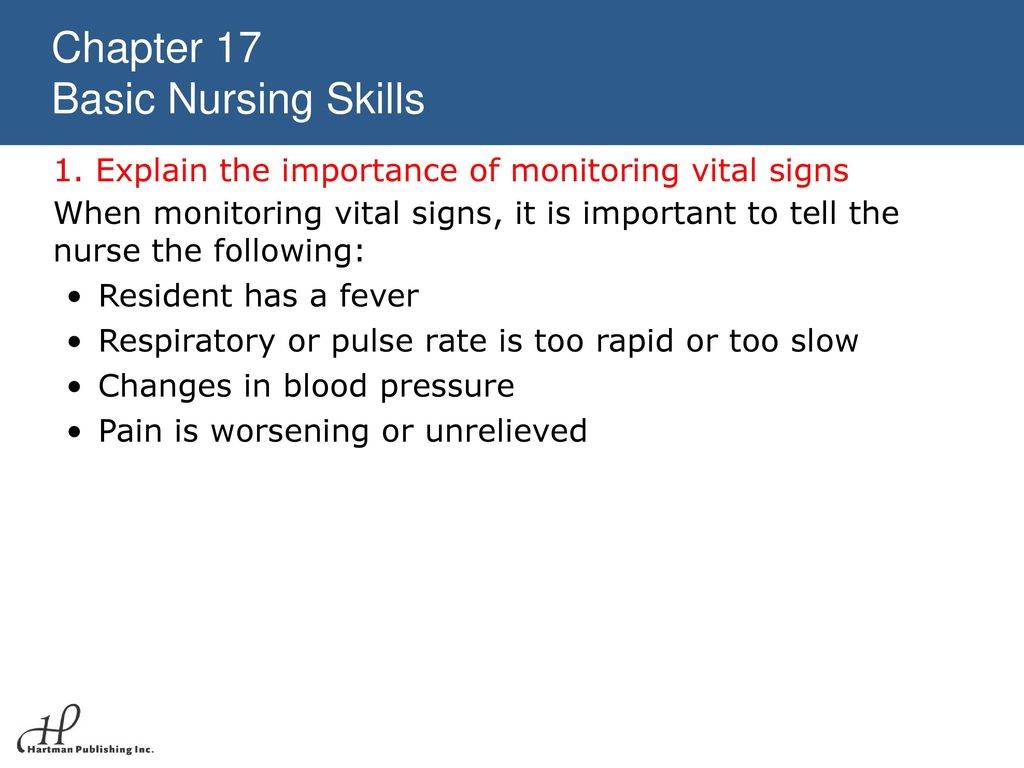List 5 Vital Signs That Must Be Monitored
Pulse Blood Pressure Respirations Temperature Pulse Oximetry Non-Invasive Blood Pressure NIBP Invasive Blood Pressure IBP Heart Rate. The eight vital signs of patient monitoring Abstract Nurses have traditionally relied on five vital signs to assess their patients.

How To Read A Vital Signs Monitor Vital Signs Vital Signs Monitor Medical School Studying
Offer warm baths or showers.

List 5 vital signs that must be monitored. Patients receiving intravenous opiates are at risk of their vital signs and consciousness levels being com-promised if the rate of the infusion is too high. There are four main vital signs routinely monitored by healthcare providers. 334 All routine Vital Signs Pulse Respiratory Rate and Blood Pressure are to be measured manually.
Patient using NEWS it is vital that the patient is observed for signs of haemor-rhage shock sepsis and the effects of anal - gesia and anaesthetic. A normal resting heart rate for adults. Encourage slow deep breathing.
Assist in frequent changes of position. Measuring body temperature Counting the pulse rate Counting the. Body temperature Pulse rate Respiratory rate rate of breathing Blood pressure.
Vitals should be assessed for a patient with. Body temperature blood pressure pulse and breathing rate respiratory rate often notated as BT BP HR and RR. Summon assistance more expert than a junior doctor without delay.
However depending on the clinical setting the vital signs may include other measurements called the fifth vital sign or sixth vital sign. Accurately measuring vitals signs is an essential aspect of resident care. Traditionally the five vital signs are blood pressure BP pulse respiratory rate oxygen saturation SpO 2 and temperature 2.
Give back rubs frequently if allowed. View Notes - Megan Bunch Day 7 Chapter Reviewsdocx from HED 2500 at Midlands Technical College. Respiration rate rate of breathing.
When routinely monitoring patients on general care floors there are 5 primary vital signs that medical professionals check. 3changes in pulse rate or rhythm. Vital signs that might be monitored include.
There are four primary vital signs. Vital signs are recorded using the. - The patient requires more frequent observation ie following an abnormal.
Vital sign monitoring is a fundamental component of nursing care. - Staff should wait 20 minutes following any activity before attending vital sign measurement. Record all vital signs frequently.
Typically a pulse oximeter uses two LEDs light-emitting diodes generating red and infrared lights through a translucent part of the body. Bone tissue pigmentation and venous vessels normally absorb a constant amount of light over time. ViTAL SigNS Temperature pulse respiration blood pressure and pain are the five main vital signs regularly monitored in healthcare settings.
1 List 5 vital signs that must be monitored. Nurses have traditionally relied on five vital signs to assess their patients. These vital signs can reveal a lot about a residents condition and are often the first indicators of illness or disease.
Megan Bunch Chapter 14 Review. However as patients hospitalised today. 2high or low blood pressure.
Normal body temperature can range from 978 degrees Fahrenheit 365 degrees Celsius to 99 degrees F 372. Were taught in nursing school that a patients pulse respirations blood pressure and body temperature are essential in identifying clinical deterioration and that these parameters must be measured consistently and recorded accurately. List five vital signs that must be monitored.
335 Automated electronic vital sign equipment is to be used only if. What are vital signs. However as patients hospitalised today are sicker than in the past these vital signs may not be adequate to identify.
View Burr Lesson 14 Discussion 1docx from NRS CNA at Nebraska Methodist College. Temperature pulse blood pressure respiratory rate and oxygen saturation. Vital signs are measurements of the bodys most basic functions.
Recognize deterioration and the urgency of a situation. Temperature pulse blood pressure respiratory rate and oxygen saturation. Monitoring vital signs is integral to patient care in acute hospitals 1.
The four main vital signs routinely monitored by medical professionals and health care providers include the following. It is therefore imperative that the. Vital Sign 3 Oxygen Saturation SpO2 A pulse oximeter is a device intended for the non-invasive measurement of blood oxygen saturation SpO2 and pulse rate.

1 Explain The Importance Of Monitoring Vital Signs Ppt Download

Normal Vital Signs You Need To Know In Nursing School Vital Signs Nursing Vital Signs Nursing Cheat Sheet

The 5 Most Important Patient Vital Signs
